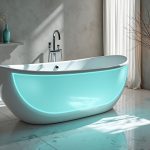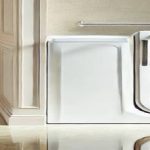As we age, we naturally seek solutions that enhance our comfort and safety, allowing us to maintain independence in our homes for as long as possible. Affordable walk-in tubs for seniors represent a practical solution to the challenges of bathing, significantly reducing the risk of falls and other accidents.
The Growing Need for Safety in the Bathroom
The bathroom is one of the most dangerous places in the home, especially for seniors. The combination of slippery surfaces and the necessity to step over high bathtub walls makes traditional bathing methods risky. According to statistics, falls are the leading cause of injury among the elderly, and many of these incidents occur in the bathroom. The need for a safer option becomes glaringly evident as seniors strive to maintain their independence and dignity.
Introducing Walk-In Tubs: A Safer Alternative
Walk-in tubs are specially designed to address the safety concerns associated with traditional bathtubs. These tubs feature a door that opens, allowing users to step into them instead of having to climb over. Key features contribute to their safety advantage over regular tubs:
- Low Entry Threshold: The low step-in threshold significantly reduces the risk of tripping, making it easier and safer to enter and exit the tub.
- Non-Slip Surfaces: Many walk-in tubs are equipped with textured, non-slip floors and seats to help prevent slips and falls.
- Built-in Grab Bars: These are essential for maintaining balance while entering and exiting the tub.
- Seated Position: This feature provides comfort and reduces the risk of falling compared to sitting on the floor of a traditional tub.
- Quick Drain Technology: This allows the tub to drain swiftly, reducing waiting time and exposure to warm water, thus minimizing potential discomfort or risk of overheating.
Affordable Options for Every Budget
The cost of walk-in tubs can vary widely based on features and installation requirements, but options exist to fit a wide range of budgets. Considering the increased safety and potential health benefits, a walk-in tub can be a valuable investment for seniors:
- Economical Models: Basic models come with essential safety features such as low step-in thresholds and grab bars, providing safety without breaking the bank.
- Mid-range Options: For a slight increase in cost, tubs with additional amenities like hydrotherapy jets, heated seats, and quick-drain systems are available, adding comfort and therapeutic benefits.
- Luxury Selections: High-end models may include features like chromotherapy lights, adjustable showerheads, and touchscreen controls for those seeking the ultimate bathing experience.
When considering a purchase, it's also wise to explore different suppliers and request multiple quotes to ensure you receive the best pricing and service available.
Walk-in Tubs can be Covered by Medicare
One of the common concerns about walk-in tubs is the out-of-pocket cost. However, seniors may be relieved to know that certain medical conditions might make it possible to obtain financial assistance. Although Medicare does not generally cover the full cost of walk-in tubs as they are considered "luxury" items, there are strategies to reduce the expense:
- Medicare Advantage Plans: Some Medicare Advantage Plans provide coverage for walk-in tubs if deemed medically necessary by a physician.
- Veterans' Benefits: Veterans may be eligible for home modification grants that can apply towards the cost of walk-in tubs.
- State Programs: Some states offer grants or low-interest loans to help cover the costs of necessary home modifications.
 Editor's Choice
Editor's ChoiceThere are many benefits to having a walk in tub installed in your home. Luckily they are easy to install and more affordable than ever before.
Understanding how these financial assistance programs work can help ease the financial burden, making walk-in tubs more financially feasible for seniors.
Get a Walk-in Tub Installed Today
Deciding on and installing a walk-in tub is a transformative step towards enhancing both safety and quality of life for seniors. Installation can be a straightforward process when handled by competent professionals, offering peace of mind that the tub will be safe and reliable:
- Consultation and Assessment: Discuss your needs with reputable suppliers who can assess your space and recommend appropriate solutions.
- Professional Installation: Hiring experienced installers ensures that the tub will function properly and safely.
- Post-Installation Support: A good supplier will offer a warranty and follow-up services to address any post-installation concerns.
What's more, installing a walk-in tub promptly allows seniors to begin enjoying their benefits right away, freeing them from the stress and challenges of traditional bathing.
The Therapeutic Benefits of Walk-in Tubs
Beyond safety, walk-in tubs offer various therapeutic advantages that can greatly enhance a senior's quality of life. The hydrotherapy features available in many models provide numerous health benefits:
- Pain Relief: Warm water and massaging jets can alleviate muscle tension, joint pain, and swelling associated with arthritis and other conditions.
- Improved Mobility: Regular use of hydrotherapy can help improve circulation and flexibility, promoting better mobility.
- Relaxation: The soothing nature of a warm bath can reduce stress and promote better sleep, vital components of overall well-being.
Conclusion: The Importance of Safety and Comfort in Aging
For seniors, ensuring safety in the bathroom is critical, and walk-in tubs offer a secure and comfortable bathing solution. Many programs and resources are available to help seniors access these tubs at no cost. Medicare Advantage plans, for instance, often cover the cost of walk-in tubs as part of their health and wellness benefits. Additionally, Medicaid programs in various states provide funding for home modifications, including walk-in tubs, if they are deemed medically necessary. Nonprofit organizations and veteran assistance programs also offer grants or subsidies for seniors needing safer bathroom setups. By researching eligibility criteria and contacting local agencies, seniors can explore these funding opportunities to improve their quality of life.
Seniors can also look into state-specific assistance programs that focus on aging in place. These initiatives often prioritize home safety modifications to prevent accidents, especially for those with limited mobility. For example, the Department of Housing and Urban Development (HUD) and other local housing authorities may offer funding through home improvement grants or loans. Additionally, some walk-in tub manufacturers collaborate with charities or provide financing options tailored to low-income seniors. By leveraging these resources and connecting with healthcare providers, seniors can find practical ways to install no-cost walk-in tubs, enhancing their safety and independence at home.
These therapeutic aspects can make a walk-in tub an investment not just in safety, but also in the longevity and overall wellness of seniors.


